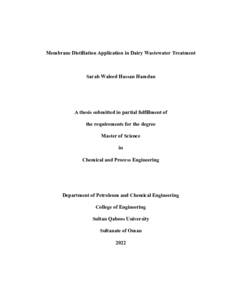Document
Membrane distillation application in dairy wastewater treatment.
Other titles
تطبيق تقنية التقطير الغشائي في معالجة المياه العادمة الناتجة من تصنيع منتجات الألبان والأجبان
Publisher
Sultan Qaboos University.
Gregorian
2022
Language
English
English abstract
Treatment of dairy wastewater (DWW) is essential for disposal purposes and for
reclaiming pure water that is usable in many water consuming areas. As a result, the
development of state-of-art techniques is vital in treating this kind of wastewater, one of
which is membrane distillation (MD). MD has been proposed for the treatment of DWW
as it was proven to have a lot of attractive aspects. Therefore, MD in direct contact
configuration (DCMD), was employed in this study to investigate its efficiency in treating
DWW. In this work, the DWW samples were provided by Mazoon Dairy Industry, Oman.
The samples were pretreated using 5-micron PP cartridge filter for suspended solids
removal. Additionally, polytetrafluoroethylene (PTFE) and polypropylene (PP)
membranes with a pore size of 0.2 µm and water contact angles of 137° and 128°,
respectively, were utilized in this study. MD experiments were conducted for a duration
of 7 hours at different feed temperatures (i.e., 40, 50 and 60°C) whereas the temperature
of the permeate side was kept constant at 23°C. Experiments using ultrapure water (UPW)
were conducted to quantify the maximum flux values achieved by both membranes. The
flux was found to be 17.3 kg/m2
.h at 40°C, 28.1 kg/m2
.h at 50°C, and around 41.7 kg/m2
.h
at 60°C for PTFE membrane, whereas in PP membrane it was 21.7 kg/m2
. h at 50°C.
Furthermore, synthetic saltwater (SW) [1250ppm] tests were done to mimic the salts
present in DWW and study their effect on MD performance. It was observed that the flux
has reduced slightly in comparison with UPW flux. This reduction in flux is justified by
water vapor pressure reduction due to the presence of salt, which reduced the amount of
vapor passing through the membrane pores. On the contrary, using DWW as feed have
led to significant flux deterioration as the feed temperature increased, due to the reduction
in the effective area available for evaporation. This is caused by dairy components
accumulation at the membrane surface. In terms of rejection using PTFE membrane, a
rejection of 99.9%, 90.2%, 96.2%, and 99.8% were obtained for TDS, BOD, COD, and
TOC respectively. In terms of volatile components rejection, it was found that D limonene, the dominant volatile component in DWW, was 100% rejected by MD.
However, traces of volatile fatty acids such as acetic acid, propionic acid, and butyric acid
were found in the permeate. After investigation of rejection factors and flux values at all
the three investigated temperatures, it was concluded that 50°C is the optimum
temperature. Therefore, PP membrane experimentations were held at that temperature.
The maximum flux achieved by PP membrane was 21.76 kg/m2
.h. Using PP membrane
accomplished a rejection of 98.4%, 91.2%, 97.5%, and 99.8 % for TDS, BOD, COD, and
TOC respectively. D-limonene was 100% rejected by PP membrane as well. In addition,
results obtained from SEM/EDS showed that there were dairy compounds deposited at the
membrane surface. EDS analysis revealed several various elements at the membrane's
surface resulted from dairy composites such as F, C, O, Na, Ca, Al, Mg, Fe, Cl, Si and Zn.
Furthermore, new peaks were exhibited by the FTIR spectrum showing the functional
groups of DWW components such as fatty acids, polysaccharides, and amides.
Additionally, TGA analysis results indicated that the thermal stability of the membranes
decreased with increasing the feed temperature. Taking into consideration the results
obtained from this work, MD has proven to be an effective technology in DWW treatment.
Member of
Resource URL
Category
Theses and Dissertations

